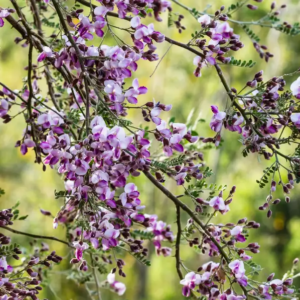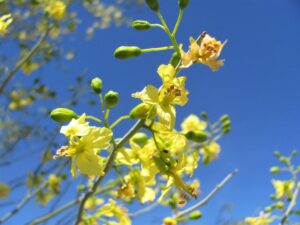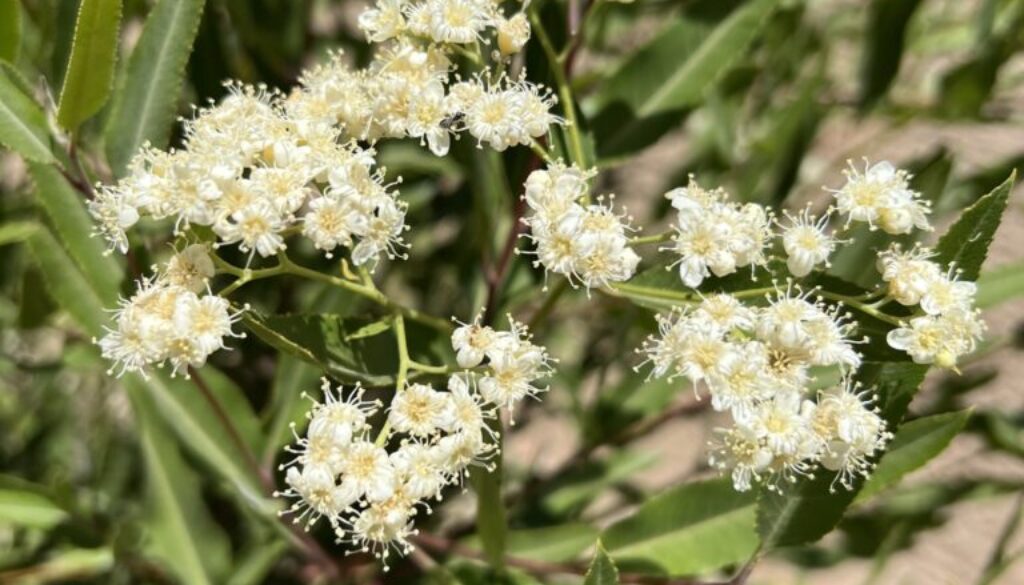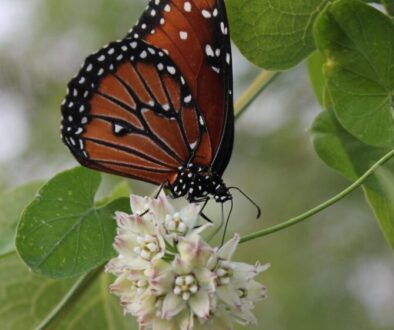Low-Mess Evergreen Trees for Arizona Landscapes
Love trees but hate the mess they make? In this month’s post, we are featuring desert-adapted evergreen trees you can enjoy in your Arizona landscape, with minimal maintenance. Although it’s rare for trees to produce zero litter, you can count on non-deciduous trees to produce minimal debris.
As always, match the right tree to the right location to maximize your enjoyment of the trees you select.

To help you select the most suitable trees for your landscape, we have listed the main characteristics of some of our favorite low-litter species, followed by more detailed descriptions.
Comparative Sizes of Low-Litter Trees at Maturity
- African sumac (Rhus lancea): 20-30’ high, 20-30’ wide; rounded canopy and cracked bark
- Arizona rosewood (Vauquelinia californica): max. 10’ high; small, slow-growing
- Brazilian pepper tree (Schinus terebinthifolius): 30-40’ high, 20-30’ wide; edible berries
- Blue Arizona cypress (Hesperocyparis arizonica): 40’ high, 30’ wide; fast-growing
- Italian cypress (Cupressus sempervirens): 30-50’ high, 5-8’ wide; striking vertical growth
- Carob (Ceratonia siliqua): 30-40’ high, 30’-40’ wide; edible seed pods
- Cascalote (Caesalpinia cacalaco): 20’ high, 15’ wide; attracts hummingbirds
- Cherry laurel (Prunus laurocerasus): 20-25’ high, 20-30’ wide; best in part shade
- Chinese pistache (Pistacia chinensis): 30-35’ high, 20-30’ wide; fast-growing; showy, deciduous fall color
- Indian laurel fig (Ficus nitida): 20-30’ high, 20-30’ wide; fast-growing, tropical-looking foliage
- Ironwood (Olneya tesota): 15-30’ high, 15-20’ wide; tolerates poor soil
- Leather leaf acacia (Acacia craspedocarpa): 10-13’ high; shrub or small tree
- Live oak (Quercus virginiana): 40-80’ high, 60-100’ wide; medium-fast growing
- Mastic (Pistacia lentiscus): 15-20’ high, 20-30’ wide; can be pruned into topiary shapes
- Mulga (Acacia aneura): 15-30’ high, 15-20’ wide; silver foliage
- Neem (Azadirachta indica): 30-40’ high, 10-20’ wide; vibrant yellow fruits attract birds
- Red cap gum (Eucalyptus erythrocorys): 30’ high, 25’ wide; long, silver-blue leaves
- Silk floss (Chorisia speciosa): 30-60’ high, 20-30’ wide; eye-catching spiny trunk
- Texas mountain laurel (Dermatophyllum secundiflorum): 8’ high, 6’ wide; small tree with hanging clusters of purple flowers
- Texas olive (Cordia boisseri): 40’ high, 25’ wide; attracts hummingbirds
- Weeping myall (Acacia pendula): 15-30’ high, 15-25’ wide; dense shade from weeping branches
- Willow acacia (Acacia salicina): 30’ high, 20’ wide; shade tree for narrow spaces
Detailed Descriptions of Low-Litter Trees for Arizona Landscapes

African sumac
The African sumac (Rhus lancea) is an evergreen tree with a wide, rounded canopy that spreads to 20-30 feet high and wide. It features dark brown, cracked bark and 4-inch-long leaves that are dark green on top and silver underneath. On female trees, its yellow spring flowers produce green berries that many bird species enjoy. It tolerates heat and poor, dry, salty soil.
Arizona rosewood
Arizona rosewood (Vauquelinia californica) trees are slow-growing shrubby evergreens that grow to about 10 feet tall. They feature dull, dark green serrated leaves and clusters of short-blooming white flowers between late April and early May. Performing best above 2,500 feet in elevation, Arizona rosewood grows in partial or full sun but yellows in the hottest Valley temperatures.
Brazilian pepper
The Brazilian pepper tree (Schinus terebinthifolius) is a dense shrub that can be pruned into a small tree that can reach 30-40 feet high and 20-30 feet wide. The Brazilian pepper features clusters of flowers 2-3 inches long in a long flowering season, September to November, with glossy fruits that ripen to red clusters of peppery edible berries.
Cypress, Arizona
Blue Arizona cypress (Hesperocyparis arizonica, formerly Cupressus arizonica) trees are native to the southwestern U.S. but do not always perform well below 6,000 feet in elevation. They are fast-growing, reaching 40 feet in height and 30 feet in width. Planted together, they can form a windbreak or a privacy screen along fence lines.
Cypress, Italian
Italian cypress (Cupressus sempervirens) trees require direct sunlight and are drought-tolerant. Their vertical, conical shape makes a strong, vertical focal point, reaching 30-50 feet high and 5-8 feet wide. Cypress trees shed small amounts when the old, interior growth ages. They can be planted in a row to provide an imposing wind break or natural barrier.
Carob
The carob or locust bean tree (Ceratonia siliqua) is an evergreen native to the Mediterranean and the Middle East. Reaching 30-40 feet tall and 30-40 feet at maturity after 20-50 years, it features a broad, hemispherical crown, sturdy branches, and a deep taproot. Female and some bisexual varieties produce summer flowers and 6-inch-long edible seed pods that taste like chocolate.
Cascalote
Cascalote (Caesalpinia cacalaco) or Mexican bushbird is a native Mexican evergreen tree that likes full sun and grows in a vase-shaped form to 20 feet tall and 15 feet wide. It grows in full sun in well-drained soil and has bright green leaves and seed pods. It attracts hummingbirds with its very showy yellow flower spikes, winter through spring.
Cherry laurel
Cherry laurel (Prunus laurocerasus) is an evergreen shrub or small tree is useful as a privacy screen. It attracts butterflies and bees with its fragrant, cream-colored flowers, followed by red berries that attract many bird species. It grows 20-25 feet tall and 20-30 feet wide but can be trained into any shape. The cherry laurel tolerates full sun and full shade but performs best in part shade.
Chinese pistache
Chinese pistache (Pistacia chinensis) is a large tree with showy orange and red leaves in late fall which it drops all at once, once a year. Chinese pistache is dioecious, which means each tree is either a male that produces pollen that has little or no allergenic qualities, or a female that produces inedible berries that are attractive to birds. It is fast-growing and enjoys full sun and fast-draining soil. At maturity, it reaches 30-35 feet in height and 20-30 feet in width and is very drought-, wind-, and heat-tolerant.
Indian laurel fig
Indian laurel fig (Ficus nitida), also called Chinese banyan, is a fast-growing, medium-sized evergreen, native to Asia and Hawaii. It features tropical-looking foliage that is glossy and dense. Its spring flowers are inconspicuous. It tolerates air pollution and grows 20-30 feet high and wide.
Ironwood
Desert ironwood (Olneya tesota) is native Sonoran Desert evergreens. The oldest know specimen is over 2,000 years old. It features green leaves and lavender flowers in late spring that mature into bright red berries. Ironwood can reach 15-30 feet tall, 15-20 feet wide, and can grow in rocky, infertile soil, but it requires full sun and 6 inches or more of annual rainfall. Its wood contains compounds known to have anti-inflammatory properties.
Leather leaf acacia
Leather leaf acacia (Acacia craspedocarpa) is a dense evergreen shrub that can be pruned to a small tree that grows slowly to 10-13 feet. Its rounded leaf petioles are silver and leathery. Native to Australia, it grows in full or reflected sun and blooms with yellow puffy flowers, spring to summer. It tolerates poor, dry, rocky soil and is frost resistant to 18 degrees Fahrenheit.
Live oak
The live oak (Quercus virginiana) tree is a broad, evergreen shade tree. It differs from typical oaks in that it is a medium-fast grower that is drought tolerant once established. It grows in full sun, 40-80 feet tall, spreading 60-100 feet wide. It features large, dense foliage for deep shade. It has subtle green flowers in spring.
Mastic
The mastic tree (Pistacia lentiscus) grows as a large shrub or small tree that is 15-20 feet high and 20-30 feet wide. It can be pruned into topiary shapes, and its resin can be chewed to clean teeth. It tolerates poor soil and hot, dry growing conditions. Spring flowers develop into small, red berries that ripen to black.
Mulga
The mulga acacia tree (Acacia aneura) is native to Africa, Asia, Australia and North America. With silver, needle-like foliage and gold flowers in mid- to late summer, the mulga is great for color contrast. Mulgas are slow growers but reach 15-30 feet in height and 15-20 feet in width and have roots that grow to 35 feet. Mulgas lose their leaves only in extreme drought conditions.
Neem
Neem tree (Azadirachta indica) is an evergreen tree native to the Indian subcontinent. It is widely used for medicinal properties and in cosmetics, producing white or yellow flowers in spring that develop into vibrant yellow fruit that attract birds and insects. It grows 30-40 feet tall and 10-20 feet wide. A neem tree is sensitive to frost and needs frost protection.
Red cap gum
Red cap gum (Eucalyptus erythrocorys) is a fast-growing Australian-native evergreen that likes full sun. It has 4-inch-long silver-blue leaves and grows to 30 feet high and 25 feet wide, serving as an effective screen. It features red buds followed by yellow clusters in the summer.
Silk floss
Silk floss tree (Chorisia speciosa) is a lush, dense tree, native to Brazil and Argentina. It likes full sun and grows to 30-60 feet in height and 20-30 feet in width. It features an eye-catching spiny trunk and deep green 5-inch-wide leaves. In the fall, the tree drops its leaves and produces showy, pink, lily-like flowers, and then produces seeds and cotton-like fibers in the seed capsules.
Texas mountain laurel
Texas mountain laurel (Dermatophyllum secundiflorum, formerly Sophora secundiflora) is a small, shrubby evergreen native to the Chihuahuan Desert. It features dark green leaves and beautiful hanging clusters of purple flowers in spring. It is frost-tolerant and grows in full sun to 8 feet tall and 6 feet wide.
Texas olive
The Texas olive (Cordia boisseri) is a medium-sized evergreen that features multiple trunks and a growing size of 40 feet high and 25 feet wide. It has narrow green leaves and produces white blossoms from February to April that attract hummingbirds. Its fruits are edible, but the seeds have been known to cause serious illness in humans. It prefers moderate summer temperatures but can withstand freezing winter temperatures.
Weeping myall
The weeping myall (Acacia pendula) is an Australian native evergreen that resembles a weeping willow, with graceful, draping grey-green foliage. It creates dense shade and features pale yellow balls in spring and winter. Frost- and drought-tolerant, the weeping myall needs full sun and is slow-growing, reaching 15-30 feet in height and 15-25 feet in width at maturity.
Willow acacia
The willow acacia (Acacia salicina), an evergreen native to Australia, is an excellent shade tree for narrow spaces. It likes full sun and grows to 30 feet high and 20 feet wide. Its spring blossoms are puffy and cream-colored.




